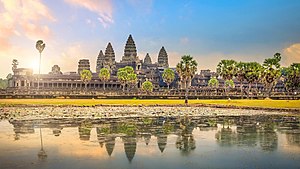Angkor Wat
Angkor Wat, located in northwest Cambodia, is the largest religious structure (temple complex) in the world by land area,measuring 162.6 hectares (1.626 km2; 402 acres). The modern name, Angkor Wat (Khmer: អង្គរវត្ត; alternative name: នគរវត្ត), means "Temple City" or "City of Temples" in Khmer.
It is said that the temple was built at the behest of King Suryavarman II in the early 12th century in Yaśodharapura (យសោធរបុរៈ, present-day Angkor), the capital of the Khmer Empire, as the state temple for the empire. Dedicated to the Hindu god Vishnu in the early 12th century, it was converted to a Buddhist temple towards the end of the 12th century.
As the best-preserved temple at the site, it is the only one to have remained a significant religious centre since its foundation. The temple is at the top of the high classical style of Khmer architecture. It is one of the most important pilgrimage sites for Buddhists in Cambodia and around the world. It has become a symbol of Cambodia, appearing on its national flag, and it is the country's main tourist attraction. Angkor Wat played a major role in converting Cambodia into a Buddhist nation.
Angkor Wat combines two basic plans of Khmer temple architecture: the temple-mountain and the later galleried temple. It is designed to represent Mount Meru, home of the devas in Hindu and Buddhist cosmology. It lies within a moat more than 5 kilometres (3 mi) long and an outer wall 3.6 kilometres (2.2 mi) long. The temple has three rectangular galleries, each raised above the next. At the centre of the temple stands a quincunx of towers. Unlike most Angkorian temples, Angkor Wat is oriented to the west. Scholars are divided as to the significance of this. The temple is admired for the grandeur and harmony of its architecture, extensive bas-reliefs, and statues of Buddhas and Devas that adorn its walls.
The construction of Angkor Wat also suggests that there was a celestial significance with certain features of the temple. This is observed in the temple's east–west orientation, and lines of sight from terraces within the temple that show specific towers to be at the precise location of the sunrise on a solstice. The temple is a representation of Mount Meru, the home of the gods: the central quincunx of towers symbolises the five peaks of the mountain, and the walls and moat symbolize the surrounding mountain ranges and ocean. [1] [2]
References
